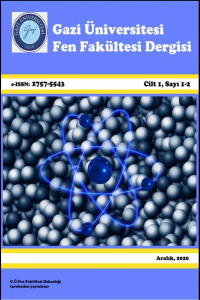Araştırma Makalesi
Yıl 2020,
Cilt: 1 Sayı: 1-2, 22 - 35, 30.12.2020
Öz
𝐿𝑝 norm ve 𝐿∞ norm parametre tahmin yöntemleri kullanılarak doğrusal ve doğrusal olmayan regresyon
modellerin parametrelerini tahmin etmek için çeşitli yapılarda modeller geliştirilmiştir. 𝐿𝑝 normunun özel bir
hali olan 𝐿1 norm ve 𝐿∞ norm yöntemlerinden geliştirilmiş modellerin karşılaştırıldığı bu çalışmada,
simülasyon çalışması ile üretilen farklı örneklem büyüklüklerindeki veri kümeleri yardımıyla katsayıların
tahmini dışında açıklayıcılık katsayısı ve hesaplama süreleri incelenmiştir. Karşılaştırılan modeller
parametre tahmini ve açıklayıcılık katsayıları açısından önemli derecede farklılık oluşturmaz iken hesaplama
süreleri açısından farklılıklara neden olmuştur.
modellerin parametrelerini tahmin etmek için çeşitli yapılarda modeller geliştirilmiştir. 𝐿𝑝 normunun özel bir
hali olan 𝐿1 norm ve 𝐿∞ norm yöntemlerinden geliştirilmiş modellerin karşılaştırıldığı bu çalışmada,
simülasyon çalışması ile üretilen farklı örneklem büyüklüklerindeki veri kümeleri yardımıyla katsayıların
tahmini dışında açıklayıcılık katsayısı ve hesaplama süreleri incelenmiştir. Karşılaştırılan modeller
parametre tahmini ve açıklayıcılık katsayıları açısından önemli derecede farklılık oluşturmaz iken hesaplama
süreleri açısından farklılıklara neden olmuştur.
Anahtar Kelimeler
Kaynakça
- [1] Gonin, R. and Money, A. H. (1989). Nonlinear Lp-norm estimation. Marcel Dekker, Inc., 1-154.
- [2] Charnes, A., Cooper, W. W., and Ferguson, R. O. (1955). Optimal estimation of executive compensation by linear programming. Management science, 1(2), 138-151.
- [3] Wagner, H. M. (1959). Linear programming techniques for regression analysis. Journal of the American Statistical Association, 54(285), 206-212.
- [4] Osborne, M. R. and Watson, G. A. (1969). An algorithm for minimax approximation in the nonlinear case. The Computer Journal, 12(1), 63-68.
- [5] Anderson, D. H. and Osborne, M. R. (1977). Discrete, nonlinear approximation problems in polyhedral norms. Numerische Mathematik, 28(2), 157-170.
- [6] Barrodale, I. and Phillips, C. (1975). Solution of an overdetermined system of linear equations in the Chebychev norm. ACM Transactions on Mathematical Software, 1(3), 264-270.
- [7] Armstrong, R. D., Frome, E. L. and Kung, D. S. (1979). A revised simplex algorithm for the absolute deviation curve fitting problem. Communications in Statistics-Simulation and Computation, 8(2), 175-190.
- [8] Murray, W. and Overton, M. L. (1980). A projected Lagrangian algorithm for nonlinear minimax optimization. SIAM Journal on Scientific and Statistical Computing, 1(3), 345-370.
- [9] Overton, M. (1982). Algorithms for nonlinear L1 and L∞ fitting. In Nonlinear optimization, Academic Press, 91- 102.
- [10] Dielman, T. E. (1986). A comparison of forecasts from least absolute value and least squares regression. Journal of Forecasting, 5(3), 189-195.
- [11] Gentle, J.E., Narula, S.C., and Sposito, V.A. (1987). Algorithms for unconstrained L1 linear regression. In: Dodge, Y. (Ed.), Statistical Data Analysis Based on the L1- Norm and Related Methods, 83–94.
- [12] Narula, S. C., Sposito, V. A., and Gentle, J. E. (1991). Comparison of computer programs for simple linear L1 regression. Journal of Statistical Computation and Simulation, 39(1-2), 63-68.
- [13] Soliman, S. A., Christensen, G. S., and Rouhi, A. (1988). A new technique for curve fitting based on minimum absolute deviations. Computational Statistics and Data Analysis, 6(4), 341-351.
- [14] Seneta, E. and Steiger, W. L. (1984). A new LAD curve-fitting algorithm: slightly overdetermined equation systems in L1. Discrete Applied Mathematics, 7(1), 79-91.
- [15] Narula, S. C. and Wellington, J. F. (1988). An efficient algorithm for the MSAE and the MMAE regression problems. SIAM Journal on Scientific and Statistical Computing, 9(4), 717-727.
- [16] Dielman, T. E. and Rose, E. L. (1994). Forecasting in least absolute value regression with autocorrelated errors: a small-sample study. International Journal of Forecasting, 10(4), 539-547.
- [17] Hong, C. S. and Choi, H. J. (1997). On L1 regression coeficients. Communications in Statistics-Simulation and Computation, 26(2), 531-537.
- [18] Portnoy, S. and Koenker, R. (1997). The Gaussian hare and the Laplacian tortoise: computability of squarederror versus absolute-error estimators. Statistical Science, 12(4), 279-300.
- [19] Weisberg, S. (2005). Applied Linear Regression. Wiley, 284-286.
Toplam 19 adet kaynakça vardır.
Ayrıntılar
| Birincil Dil | Türkçe |
|---|---|
| Bölüm | Araştırma Makaleleri |
| Yazarlar | |
| Yayımlanma Tarihi | 30 Aralık 2020 |
| Yayımlandığı Sayı | Yıl 2020 Cilt: 1 Sayı: 1-2 |


